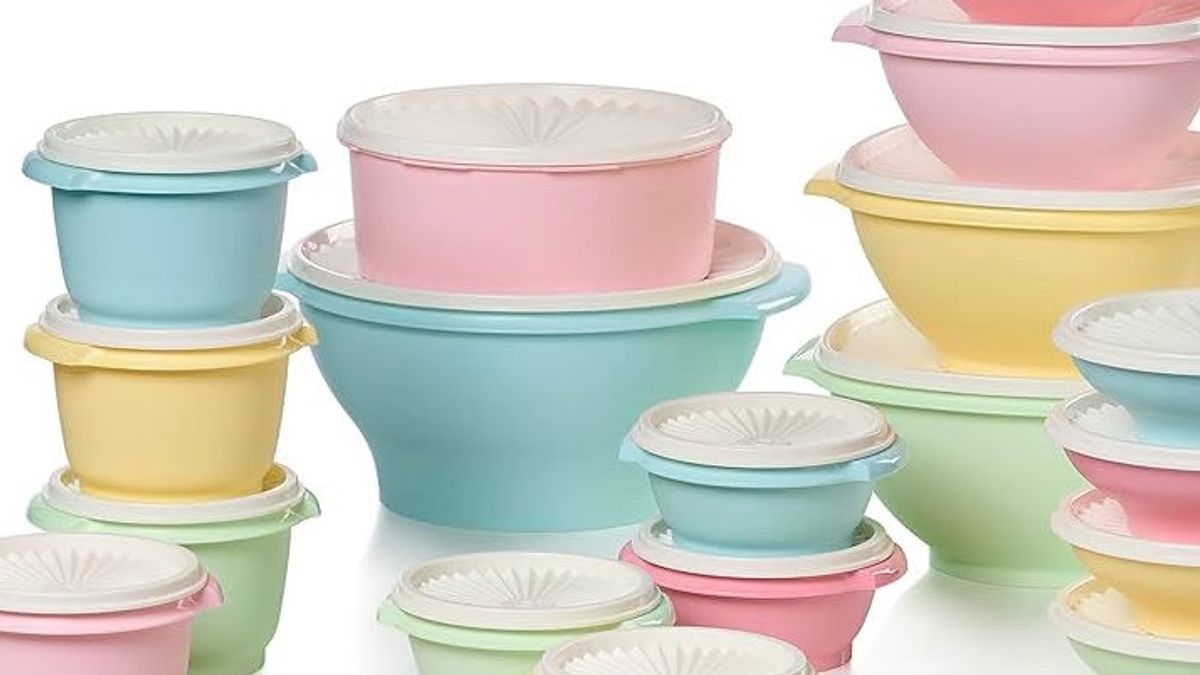جاكرتا - أفلست شركة Tupperware التجارية للحاويات البلاستيكية من الولايات المتحدة رسميا. تقدمت الشركة بطلب للحصول على حماية الإفلاس من الفصل 11 لأنها لم تعد قادرة على البقاء على قيد الحياة عندما تستمر المبيعات في الانخفاض. في السابق ، تمكنت Tupperware من أن تصبح العلامة التجارية المفضلة للأمهات في مختلف البلدان ، بما في ذلك إندونيسيا.
أعلنت Tupperware أنها قدمت طلبا للإفلاس إلى محكمة الإفلاس A لمنطقة ديلاوير يوم الثلاثاء (17/9/2024) قبل منتصف الليل بالتوقيت المحلي ، بعد أن شككت العلامة التجارية سابقا في قدرتها على الاستمرار في إدارة أعمالها في أغسطس من نفس العام.
خلال جائحة COVID-19 ، زادت مبيعات Tupperware بالفعل ، لكن الوضع تغير بالفعل بعد انتهاء الوباء.
"الشركة لديها ديون بقيمة 812 مليون دولار أمريكي (حوالي 12.4 تريليون روبية)" ، يقرأ ملف المحكمة.
وقالت الشركة على نفس الموقع: "يحاول المقرضون الجدد استخدام وضع ديونهم لمصادرة أصول Tupperware بما في ذلك الملكية الفكرية مثل علاماتها التجارية ، مما يشجع الشركات على السعي للحصول على حماية الإفلاس".
نقلا عن الموقع الرسمي للشركة ، تم تقديم منتجات Tupperware لأول مرة في 1940s في ماساتشوستس من قبل Earl S. Tupper ، وهو خبير كيميائي. استلهم Tupper عند صنع الطباعة في مصنع بلاستيكي ، بعد فترة وجيزة من الاكتئاب الكبير (1929-1939). أراد مساعدة الأسر المتعبة من الحرب التي توفر المال لتخزين الطعام.
أطلقت Tupper أول منتج لها ، وهما حاويات تخزين الأطعمة Wonderlier Bowl و Bell Tumbler في عام 1946. لإدارة أعمالها ، طبقت Tupperware طريقة Tupperware Home Party أو Tupperware Party ، والتي استخدمها رجال الأعمال Brownie Wise لأول مرة.
قام بالترويج لمنتجات Tupperware من خلال إقامة حفلات في منازل الناس. في الحفل ، جاءت المعدات المستخدمة والمعرضة من Tupperware. بفضل الطريقة التجارية ، تم تعيين Wise نائبا لرئيس التسويق لشركة Tupperware
وقال الموقع الرسمي للشركة إن "برمجيات التوبيخ تجد حلولا لنفايات الطعام، وتمكين ريادة الأعمال للمرأة من خلال المبيعات الاجتماعية، وجعل الحفلات المنزلية تحظى بشعبية".
وكلاء المبيعات الذين تكون النساء عادة ما يدعون النساء الأخريات للحضور إلى منازلهم لمشاهدة وشراء منتجات Tupperware المختلفة. ليس فقط نموذجا فعالا للتسويق المباشر ، أصبحت Tupperware Party أيضا حدثا اجتماعيا شائعا. من هذه الطريقة ، تمكنت منتجات Tupperware من السيطرة على الأسر في الولايات المتحدة وحتى العالم.
نمت برامج Tupperware بسرعة في 1960s عندما تم بيع منتجاتها في أوروبا وأمريكا الوسطى وأمريكا الجنوبية. حتى الآن ، تدعي Tupperware أنها نجحت في بيع المنتجات في 70 دولة.
في إندونيسيا وحدها ، بدأت مبيعات Tupperware في عام 1991. في عام 2013 ، أصبحت إندونيسيا أكبر سوق ل Tupperware ، حيث وصلت معدلات المبيعات إلى أكثر من 200 مليون دولار أمريكي و 250 ألف موزع.
تحولت برامج Tupperware إلى علامات تجارية معبودة للأمهات في ذلك الوقت. شائعة جدا ، غالبا ما يشار إلى اسم Tupperware لإشارة حاويات المائدة البلاستيكية ذات العلامات التجارية المختلفة ، كما يشير معظم الناس إلى المياه المعدنية باسم Aqua. بسعر مرتفع إلى حد ما مقارنة بالعلامات التجارية الأخرى ، فإن وجود Tupperware هو فخر ، ولهذا السبب يصاب الكثير من الناس بالجنون.
ولكن مع مرور الوقت ، هناك المزيد والمزيد من خيارات منتجات العلامات التجارية الأخرى ذات التصاميم الأكثر تنوعا والأسعار أكثر بأسعار معقولة.
"في الآونة الأخيرة ، انتهى حفل Tupperware" ، قالت سوزانا ستريتر ، المحللة من شركة الخدمات المالية Hargreaves Lansdown.
وأوضح عدة أسباب دفعت Tupperware إلى انهيار ، على سبيل المثال ، أخطاء الإبلاغ المالي التي حدثت في عامي 2021 و 2022. بالإضافة إلى ذلك ، قال Streeter أيضا إن هناك تغييرا في سلوك المستهلك مما جعل الحاويات البلاستيكية لا تحظى بشعبية كبيرة.
وقال ستريتر: "التغيرات في سلوك المشتري تجعل حاوياتهم عفا عليها الزمن ، حيث بدأ المستهلكون في القضاء على الإدمان على البلاستيك ويجدون طرقا أكثر ملاءمة للبيئة لتخزين الطعام".
ويتماشى ذلك مع نتائج أبحاث شركة تيترا باك، وهي شركة سويسرية لمعالجة وتعبئة الأغذية والمشروبات، والتي تظهر أن غالبية المستهلكين يميلون الآن إلى شراء المنتجات من الشركات التي تظهر اهتماما بالبيئة. لذلك ، يتم التخلي عن المنتجات البلاستيكية بشكل متزايد ، بما في ذلك Tupperware التي أصبحت معبود الأمهات في إندونيسيا.
تعتبر تقنيات مبيعات Tupperware أيضا واحدة من الأسباب التي تجعل من الصعب على هذه العلامة التجارية المنافسة في العصر الرقمي. كما ذكر سابقا ، يتم بيع 90 في المائة من منتجات Tupperware مباشرة أو بيعها مباشرة بالإضافة إلى التسويق متعدد المستويات المعروف (MLM).
وفقا لتحليل Seeking Alpha ، فإن نهج MLM هو نموذج أعمال محدود للغاية على المدى الطويل. على الرغم من أنه يؤدي إلى مبيعات قوية ومتكررة ، إلا أنه لا تزال هناك أوجه قصور كبيرة بما في ذلك الأسعار باهظة الثمن مقارنة بالمنتجات المنافسة ، وكذلك انخفاض التعرض.
خاصة في عصر اليوم ، عندما تسمح المبيعات عبر الإنترنت للمستهلكين بالوصول إلى المزيد من المنتجات عالية الجودة ، حتى بأسعار أقل. تواجه صناعة MLM تحديات كبيرة لتكون قادرة على النمو.
"حتى مع 100 إطلاق منتج جديد وزيادة التسويق للحصول على شركاء مبيعات في الأسواق النامية ، يعد نموذج أعمال MLM أحد النماذج التي يبدو أنها غير قادرة على المنافسة في العالم الحديث مع منافسين عملاقين مثل Wal-Mart و Costco و Amazon" ، قال تحليل Seeking Alpha.
نقلا عن الشركة السريعة ، فإن Tupperware لم تكن متأصلة حقا في المبيعات عبر الإنترنت حتى عصر 2020-an. افتتحوا للتو متجرا رسميا على أمازون في يونيو 2022 وفي أكتوبر من نفس العام بدأت الشركة في بيع منتجاتها على Target.com. يمكنك القول أن Tupperware تأخر في الدخول من خلال اثنين من أكبر التجارة الإلكترونية في الولايات المتحدة.
وقال محلل التجزئة والمدير التنفيذي لشركة GlobalData Retail Neil Saunders إن برامج Tupperware شهدت انخفاضا حادا بعد الوباء ولا تزال تعتبر غير متصلة بالمستهلكين الشباب.
وقال ساوندرز: "كانت الشركة الأكثر ابتكارا مثل الأدوات المتطورة في المطبخ ، لكنها الآن فقدت مزاياها تماما".
The English, Chinese, Japanese, Arabic, and French versions are automatically generated by the AI. So there may still be inaccuracies in translating, please always see Indonesian as our main language. (system supported by DigitalSiber.id)









